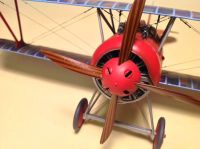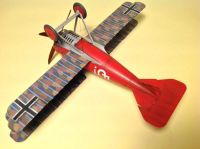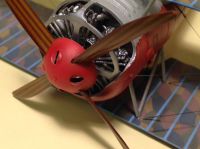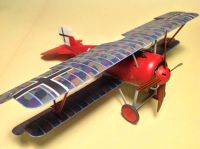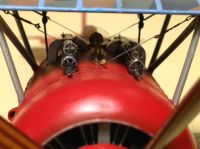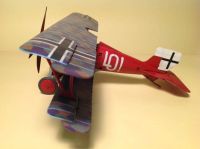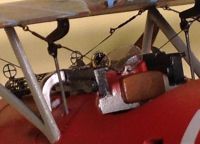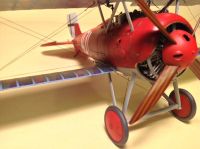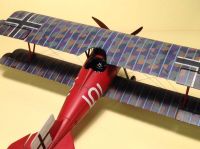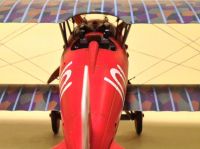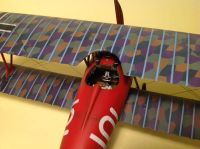Roden 1/32 Siemens Schuckert Werke DIII
By Russell Bucy

Lo! - Ernst Udet's Siemens Schuckert Werke DIII
History
After reading the book "The Aviators" I wanted to know more about Ernst Udet, Germany's second highest scoring German WWI ace with 62 aerial victories. During one engagement with France's leading Ace Georges Guynemer, Udet's guns jammed, and Guynemer had him at his mercy. Instead of shooting him down, Guynemer flew along side him for a while and saluted-- this story undoubtably helped contribute to the "myth" of aviation "chivalry" during WWI. Udet's life intersected with many other early aviators, including three from the US - Rickenbacker, Lindberg, and Doolittle who are the focus of "The Aviators" (a great book by the way). Udet graciously hosted all three at his home in Germany to discuss aviation progress in the 1930s - he and Doolittle had some wild times! Udet was by all accounts a bit of a reckless character, quite a partier, and a talented stunt pilot, traveling extensively in North and South America. He attended the Cleveland Air Races, and flew in several movies. During the First World War, he flew a succession of aircraft, including the Siemens Schuckert Werke DIII (SSW DIII). Several of his WWI aircraft sported a red fuselage with "LO" in large white letters - his nickname for his fiancée - Eleanor "Lola" Zink. When the Nazis took power in 1933, Udet was forced by Goering to become the director of aviation procurement, and was responsible for development of the Ju 87 Stuka and the Bf 109, which he personally test flew. However, he was never a Nazi, and Goering used him as a scapegoat for the Luftwaffe's early failures, leading to Udet's suicide in November 1941. A sad end for a great flyer.
Introduced in April 1918, the SSW DIII had a massive Siemens Halske eleven cylinder rotary engine (known as the Sh III) and a four bladed prop. It was powerful, highly maneuverable, and had excellent performance at higher altitudes. The Sh III had an internal gearing in which the cylinders and crankcase moved in an opposite direction from the crankshaft, which greatly reduced the effects of inertia on the aircraft. Some sources confuse this with "counter-rotation" of the propeller, but this is not the case as the prop is fixed to the crankcase. Although inventive, the Siemens Halske design used mineral oil for lubrication due to a shortage of castor oil, and the Sh III engine tended to overheat, shortening it's service life to about 10 hours. The SSW DIIIs were all withdrawn from service in May 1918 to replace their engines and cowlings with the new Sh IIIa engine and a cut down cowling, with air scoops added to the prop hub to increase cooling. The new Sh IIIa engine and cowling increased engine life to about 40 hours. The SSW DIIIs were returned to the front by July 1918 at the demand of its former pilots, who thought they were exceptional dog fighters. They were joined in August 1918 by the SSW DIV which had a shorter wing cord. Only 50 SSW DIIIs made it into front line service, along with another 50 or so SSW DIVs, even though nearly 230 were ordered by the German Air Service. German and Allied pilots that test flew them describe them as the best fighter to emerge from WWI.
The Kit
Roden has provided us with some nice 1/32 kits over the years, and this is one of them, but it's not without a few warts. It comes with a complete cockpit, nice engine detail, a one piece upper wing with appropriately thin trailing edges, separate ailerons, rudder, horizontal stabilizers, a full decal sheet with lozenge wings and markings for four different SSWs. However, the moldings have a bit of flash and there are some heavy sprue gates. Some of the cowling and fuselage parts have rough texture in some areas, and the panel lines on the fuselage are a little heavy. The fit is not the greatest in the fuselage and lower wing roots. This is compounded by Roden's use of very hard plastic, which increases the effort in sanding and cutting. The older Roden decals also have a tendency to adhere poorly - however I discovered with a little application of heat this can be overcome. If you have some modeling experience and patience, this kit will yield a very nice model.
Modifications
- The cockpit was detailed up a bit with Eduard's 1/32 SSW photo etch set. After rigging the interior with control wires, I added the throttle, belts and instruments from the set. I also constructed a seat cushion from Milliput.
- Before closing up the fuselage, I carved out the prominent fuselage hand-holds using tube and sheet styrene to back them, and replaced the molded in hand-holds with short sections of square styrene rod. The two air scoops on the forward fuselage were also drilled and carved out.
- Using a dental burr mounted in my variable speed Dremel, I carefully opened the louvers and vents at the bottom of the forward fuselage. Clearing these louvers and vents is probably the single most difficult and tedious job on the model, but doing this really sets off that big engine compartment.
- Attaching the lower wings was a challenge, as they have large gaps that had to be filled and sanded where they attach to the fuselage sides, while keeping the wings in the proper dihedral. Lots of filler was used here to get the proper shape of the wing roots at the trailing edge of the wing. I replaced the overly thick rod and counterbalance system for the ailerons with brass rod drilled into the ends of the counterbalances.
- The kit engine is nicely detailed. I wired the plugs with very thin copper armature wire. Aligning the 22 pushrods was an effort, but once accomplished, the engine looks pretty good. Be careful of the cylinder cooling fins - they are very finely reproduced but can easily be "erased" by excess glue or sanding. I painted my engine black Alclad Micro-primer & Porefiller, then gave it a coat of Alclad Aluminum. The ends of the cylinders received a light coat of Alclad "Hot Metal Blue", which was followed by a thin wash of Testor's Model Master Burnt Umber. After painting the firewall in Alclad aluminum, the engine was mounted on a brass rod that passes through a brass tube in the firewall. It just hangs there until the cowling with its engine support framework is attached.
- Roden thoughtfully offers a choice of Spandau guns with solid styrene cooling jackets, or the guns with just a barrel and no cooling jacket. I replaced the barrels of the guns with hypodermic needles, and built flash suppressors using Albion fine brass tube. I annealed a set of "Foto-cut" 1/32 Spandau jackets I had in my spares box, rolled them and attached them to the guns. The set also came with sights, which were glued to the guns. Getting the ammo feed chutes into position is a little difficult - I eventually removed the guns, glued the chutes to them and repositioned them in the fuselage - an effort that cost me one of the chutes to the "carpet monster" in my garage, where I do most of my modeling - so the chute had to be carved and shaped from sheet styrene stock.
- Unfortunately, the cowling has a bit of flash, and the cross-shaped engine supports needed some filler as there were some sink marks in my kit. During dry fitting, I found the cowling did not fit well over the engine. I did some interior carving and sanding to get the engine to rotate - this took a lot of work to get right. Once done, I painted the interior with Alclad primer and aluminum paint, then I attached the cowling to the fuselage, effectively "locking" the engine into place. Two small tabs from the Eduard set were then glued using cyanoacrylate to the lower corners of the cowling for rigging lines.
- I mounted the prop on a wooden skewer and painted it Tamiya Deck Tan, then masked off the laminations, and airbrushed it with Tamiya NATO brown. After that was dry, I used Windsor and Newton Brown oil paint applied with a piece of fine sponge rubber brushed along the width of the prop, not the length. This gives a cross section finish of the lamination. To speed up the drying of the oils, I airbrushed a thin coat of Dullcoat, followed by Tamiya clear orange, which gives a nice warm coloring to the prop.
- I attached the tail empennage with deflected stabilizers, and assembled and attached the landing gear per the kit instructions. I masked the engine and cockpit and airbrushed a coat of gray primer. I followed this up by doing a pre-shade with flat black. The forward fuselage and wing root areas were given a coat of 50/50 Testors square bottle silver and flat medium gray, this mixture was thinned with 50% Testor's airbrush thinner. This gives a nice, deep "smooth gray" color to approximate a "painted metal" look. After masking, I applied the red fuselage color.
- Roden recommends a light gray or tan for the wing surfaces beneath the lozenge decals. I used Tamiya light gray on the tops and bottoms of the wings. I have several Roden kits in my stash of WWI aircraft, but this was my first experience using their decals since I normally use aftermarket decals. I applied them in the normal way, and used plenty of Solvaset to no avail. No matter what I tried, the decals just curled and peeled up when dry. In retrospect, I wish I'd tried a smaller decal first, because I learned the "secret" to get them to conform is to apply heat to the decal as it dries, but unfortunately my upper wing decal was destroyed. Fortunately, I had an old set of aftermarket "Battle Axe" Lozenge decals lying around, which are nice decals (unlike Battle Axe kits!) The SSW DIII primarily used five color lozenge, not the four color Battle Axe lozenge decals I had. I have two references that show the 4 color lozenge for Udet's SSW DIII, but I think it's more likely the SSW DIII had the 5 color lozenge. I used the Battle Axe decals anyway, but had to cut them on an angle since the since SSWs Lozenge was applied diagonally over the wing surface. It may be a trick of perspective, but no one (but me, - and now you) recognizes that my SSW hasn't got the five color lozenge. I used the kit decals for the rest of the build, applying them and carefully playing the heat from a small travel hair dryer over the model with lots of Solvaset decal set. The blue rib tapes came from an old Microscale decal sheet for 1/48 aircraft - but look pretty good on this 1/32 scale model, one source I have shows Udet's SSW DIII with "Salmon" colored tapes - but I don't think anyone really knows for sure.
- The model was carefully "weathered" with a light application of 25/75% mixture of Testors Model Master Burnt Umber to thinner airbrushed at 8-10 PSI over the upper and lower wing and tail surfaces, and selected areas of the forward fuselage. The SSW DIII was not in service very long, so most weathering was kept to a minimum. I used a silver Prismacolor artists pencil to do some minor "chipping" around the metal cowling and forward fuselage in the area of the inspection ports and riveting. To finish it up, the model was airbrushed in a very light coat of Testor's Metalizer Sealer mixed 50/50 with Testor's airbrush thinner.
- I normally rig my models with 4lb test Brown "Chameleon" fishing line, but this time decided to use E-Z Line from Berkshire Junction (available from Wingnut Wings) as an experiment. I also used Eduard turnbuckles. I think I prefer the fishing line the best, but the E-Z line looks OK.
Conclusions
I like Roden's line of 1/32 scale kits, but often they require some work to get the fit right. This kit is no different. If you have some experience with biplanes, the SSW DIII won't be too hard to build, but I don't recommend it for beginners. I learned my lesson with Roden's decals - which I think are quite nice, but need an application of heat to work well. There are not a lot of parts in the box for this kit, which is one reason I like it. Except for the notes above, this was a pretty much "out of the box" build for me that took about 45 hours, some of which was due to mistakes of my own doing.
References
- Aircraft in Profile #86, Siemens Schuckert DIII & DIV, Peter Gray. Doubleday Pub.
- Classic WWI Aircraft Profiles Vol. 1, Terry Treadwell & Edward Shacklady. Cerberus
- Aircraft of WWI 1914-1918, Jack Herris & Bob Pearson. Amber Publishing
- Eagles of the Black Cross, Walter Musciano. Ivan Oblansky Publishing
- The Great Air War, Aaron Norma. Macmillan Publishers
- Kaiser's Aces, Marek Murawski. Kagero Publishing
© Russell Bucy 2017
This article was published on Friday, July 07 2017; Last modified on Friday, July 07 2017

